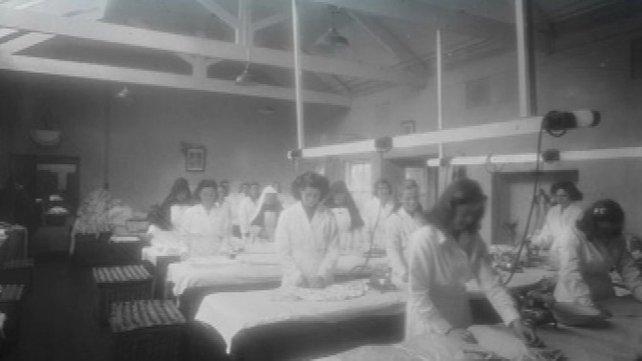Dr Lorraine Grimes, of Maynooth University, in Ireland, examines the scandal of the repatriation of thousands of unmarried women and girls from Britain to Ireland from the 1930s to the 1970s.
Dr Grimes was recently featured in an article on the BBC website (click here) which reported on the case of Maria Cahill, who was six weeks old when her mother, Philomena, was repatriated from Britain to Ireland by the state and religious charities.
Maria was born in London – a British citizen – yet was also sent to one of Ireland’s secretive mother-and-baby homes, which were regarded as places of punishment for sin. She was separated from her mother two years later.
Here, Lorraine provides a more general analysis of this scandal.
****
For the bulk of the Twentieth Century, having a child outside of marriage brought great shame on the woman and her family. It is not that long ago that many women were forced to enter institutions in Britain to hide their shame. Similar institutions were also a feature in other countries in the western world and have been the subject to governmental inquiries in recent years.
The institutions stemmed from the Poor Law Acts of the 1830s. Magdalene Laundries which were initially as places of “redemption” or “rehabilitation” for women who engaged in prostitution, became places to hide women who portrayed as “deviant”, were sexually active before marriage or were often young girls who had nowhere else to go.
Many women who suffered sexual abuse and trauma were deemed ‘mad’ and were subsequently institutionalised without offering any real support. Women pregnant outside of marriage in Victorian England could be sent to prison for “bearing an illegitimate child”. However, most ended up in the workhouse.
Moral disobedience
The link between poverty and “moral disobedience” was used as a means to control women. Under the Poor Law, an unmarried mother could be committed to a mental asylum without medical diagnosis if she was under the age of twenty-one years and had been committed by a guardian. This legislation was not repealed in Britain until 1959.

‘while the repatriations were supposed to be optional, a number of mothers she had spoken to “felt it was completely forced – that they did not have a choice”.’
Mother and baby “home” institutions were founded in the twentieth century and were similar to the Magdalene Laundries but catered specifically for unmarried mothers. Questions remain unanswered regarding consent and coercion in adoptions from these institutions. Many survivors of institutions in Britain have come forward to say that they did not consent to the adoption of the child. The extent of this has yet to fully be revealed.
Mother and baby institutions were usually run by religious congregations or a philanthropic organisation and were funded by the local city or county councils in Britain. Standards within the institutions varied; some women paid a fee towards their stay, others who had worked could use the stamps earned towards their stay. Other institutions catered to those who could not contribute. The “cost” of catering to these women was emphasised by welfare organisations, particularly those who were not from Britain.
The Repatriation of Unmarried Mothers
In Ireland, the lack of adequate state support, and the shame and stigma associated with pregnancy outside of marriage, meant many women who became pregnant outside of marriage migrated to Britain in an attempt to hide their pregnancy. During the Twentieth Century, many Irish men and women travelled to Britain to find work and a large Irish migrant population existed.
It is obviously very difficult to define the number of Irish women who travelled to Britain because of pregnancy outside of marriage. Some “welfare organisations” in Britain reported hundreds annually throughout the twentieth century. One in Liverpool recorded that it assisted 1,947 pregnant Irish women from 1926 to 1930. Westminster Office for Social Work noted 327 applications from unmarried Irish mothers in 1938 alone.
Religious welfare organisations in Britain continually emphasised the cost to the religious bodies and to “the British taxpayer” in keeping these women in institutions. A repatriation scheme was devised where there was an organised return of Irish unmarried mothers and their children.

The scheme was organised in 1930 by the Irish High Commission in London (later the Irish Embassy) and the Department of Local Government and Public Health in Ireland. Irish women were repatriated sometimes in late-stage pregnancy and quite often without their consent. If the woman refused to travel, her infant was sometimes repatriated without her.
Legal rights jeopardised
Although legally an Irish woman had the legal right to live and work in Britain, once she became pregnant outside of marriage, this legal right was jeopardised. Speaking to women who had been repatriated, they said they did not know the scheme was “voluntary” and many were forced against their will to return to Ireland. A conservative estimate of this forced repatriation from Britain to Ireland would be about 5,000 women and children from the 1930s to 1979
As the 1950s and 1960s progressed, migration to Britain from the colonies increased and Irish women were no longer the only immigrant community targeted in this manner. Records show that in the 1960s, the Colonial Office Britain began repatriating children of unmarried mothers from the West Indies, particularly Jamacia.
Institutionalisation dominated welfare for unmarried mothers in the nineteenth and twentieth century and was used as a means of controlling working class women. Repatriation schemes were used as a means of removing from Britain women who had come from former colonised countries and returning them to their home country.
Survivors of institutionalisation, forced repatriation and forced adoption have yet to be acknowledged by the British state. They deserve an official apology from both Church and State and to be offered state funded support. There should be open, free and easy access to all archival records in the field and an investment in research in the area which is both inclusive and trauma-informed.



